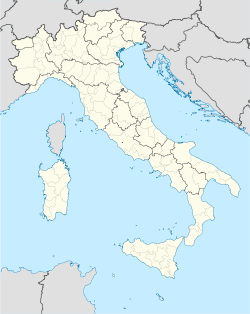- Civita Castellana
-
Civita Castellana — Comune — Comune di Civita Castellana Piazza Matteotti in Civita Castellana by night. 
Coat of armsLocation of Civita Castellana in Italy Coordinates: 42°17′N 12°24′E / 42.283°N 12.4°ECoordinates: 42°17′N 12°24′E / 42.283°N 12.4°E Country Italy Region Lazio Province Viterbo (VT) Frazioni Borghetto, Pian Paradiso, Sassacci Government - Mayor Gianluca Angelelli Area - Total 83.28 km2 (32.2 sq mi) Elevation 145 m (476 ft) Population (2008) - Total 16,722 - Density 200.8/km2 (520.1/sq mi) Demonym Civitonici Time zone CET (UTC+1) - Summer (DST) CEST (UTC+2) Postal code 01033 Dialing code 0761 Patron saint Sts. John and Marcianus Saint day September 16 Website Official website Civita Castellana is a town and comune in the province of Viterbo, 65 km north of Rome.
Mount Soracte lies about 10 km to the south-east.
History
Civita Castellana was settled during the Iron Age by the Italic people of the Falisci, who called it Falerii. After the Faliscan defeat against the Romans, a new city was built by the latter, about 5 km away, and called Falerii Novi.
The abandoned city was repopulated beginning in the early Middle Ages, with the new name of Civita Castellana (roughly translated as "City of the Castle") mentioned first in 994. In the following centuries the city was a flourishing independent commune, often contended by the Pope and the Holy Roman Empire. Captured by Pope Paschal II at the beginning of the 12th century, the city was given as fief to the Savelli by Gregory XIV.
Sixtus IV assigned the city to Cardinal Rodrigo Borgia, the future Pope Alexander VI, who started the construction of the Rocca ("Castle"), which was completed under Julius II.
Civita Castellana became an important road hub with the connection to the Via Flaminia (1606) and the construction of Ponte Clementino after the French victory against a Neapolitan army in 1709.
Main sights
The cathedral of Santa Maria di Pozzano (Santa Maria Maggiore) possesses a fine portico, erected in 1210 by Laurentius Romanus, his son Jacobus and his grandson Cosmas, in the Cosmatesque style, with ancient columns and mosaic decorations. The interior was modernized in the 18th century, but has some fragments of Cosmatesque ornamentation. The high altar is made out of a Paleo-Christian sarcophagus of the 3rd or 4th century. The ancient crpyt and the old sacristy are also home to examples of central Italian medieval art.
The church of Santa Chiara has a Renaissance portal from 1529, while the Church of the Carmine has a noteworthy, small belltower from the 12th century, including antique Roman elements.
The Rocca (citadel) was erected by Alexander VI from the designs of Antonio da Sangallo the Elder, over pre-existing fortifications, and enlarged by Julius II and Leo X.
Ponte Clementino, the bridge by which the town is approached, dates to the 18th century.
The town also contains the ruins of the Castle of Paterno, where, on 23 January 1002, Emperor Otto III died at the age of 22.
The National Museum of the Faliscan Countryside contains findings from the ancient Falerii and the surrounding areas.
Sources and references
- Boscolo, Silvia, Luca Creti, Consuelo Mastelloni (1993) Il pavimento cosmatesco della Cattedrale di Civita Castellana. Biblioteca e società 23(1-2).[1]
 This article incorporates text from a publication now in the public domain: Chisholm, Hugh, ed (1911). Encyclopædia Britannica (11th ed.). Cambridge University Press.
This article incorporates text from a publication now in the public domain: Chisholm, Hugh, ed (1911). Encyclopædia Britannica (11th ed.). Cambridge University Press. This article incorporates text from a publication now in the public domain: Herbermann, Charles, ed (1913). Catholic Encyclopedia. Robert Appleton Company. [2]
This article incorporates text from a publication now in the public domain: Herbermann, Charles, ed (1913). Catholic Encyclopedia. Robert Appleton Company. [2]
Lazio · Comuni of the Province of Viterbo Acquapendente · Arlena di Castro · Bagnoregio · Barbarano Romano · Bassano Romano · Bassano in Teverina · Blera · Bolsena · Bomarzo · Calcata · Canepina · Canino · Capodimonte · Capranica · Caprarola · Carbognano · Castel Sant'Elia · Castiglione in Teverina · Celleno · Cellere · Civita Castellana · Civitella d'Agliano · Corchiano · Fabrica di Roma · Faleria · Farnese · Gallese · Gradoli · Graffignano · Grotte di Castro · Ischia di Castro · Latera · Lubriano · Marta · Montalto di Castro · Monte Romano · Montefiascone · Monterosi · Nepi · Onano · Oriolo Romano · Orte · Piansano · Proceno · Ronciglione · San Lorenzo Nuovo · Soriano nel Cimino · Sutri · Tarquinia · Tessennano · Tuscania · Valentano · Vallerano · Vasanello · Vejano · Vetralla · Vignanello · Villa San Giovanni in Tuscia · Viterbo · Vitorchiano
Categories:- Cities and towns in Lazio
- Communes of the Province of Viterbo
- Falisci
Wikimedia Foundation. 2010.



